Early Mylonitization in the Nevado-Filábride Complex (Betic Cordillera) during the High-Pressure Episode: Petrological, Geochemical and Thermobarometric Data
Abstract
:1. Introduction
2. Geological Setting
2.1. The General Lithological Succession of the Nevado-Filábride Complex
2.2. Antecedents about the Fine-Grained Studied Rocks
2.3. Situation of the Studied Rocks
3. Methods
3.1. Optical and Scanning Electron Microscopy
3.2. X-ray Diffraction
3.3. Chemical Analysis of Whole Samples (X-ray Fluorescence and Inductively Coupled Plasma-Mass Spectrometry)
3.4. Electron Microprobe Analyses and Derived X-ray Compositional Maps
3.5. Phase Equilibria Modelling
4. Results
4.1. Petrographic and SEM Results
4.2. X-ray Diffraction and Illite “Crystallinity”
4.3. Chemical Composition of Micas
4.4. Compositional Zoning of Garnet
4.5. Whole-Rock Analyses
4.5.1. Major Elements
4.5.2. Minor and Trace Elements
4.6. P-T Conditions Modelled from Garnet
5. Discussion
5.1. Slate-Like Rocks and Schists Protolith
5.2. Slate-Like Rock and Schist Metamorphic Grade
5.3. Framing of Results with the Geological Setting
6. Conclusions
Supplementary Materials
Author Contributions
Funding
Data Availability Statement
Acknowledgments
Conflicts of Interest
References
- Jabaloy, A. La Estructura de la Región Occidental de la Sierra de los Filabres (Cordilleras Béticas); Universidad de Granada, Monografía Tierras del Sur: Granada, Spain, 1993; p. 200. [Google Scholar]
- Sanz de Galdeano, C.; López-Garrido, A.C. The Nevado-Filábride Complex in the western part of Sierra de los Filabres (Betic Internal Zone), structure and lithologic succession. Bol. Geol. Min. 2016, 127, 823–836. [Google Scholar] [CrossRef]
- Sanz de Galdeano, C.; Santamaría-López, A. The lithological sequence of the Nevado-Filábride complex (Betic Internal Zone) in the Sierras Nevada and Filabres. Rev. Soc. Geol. Esp. 2019, 32, 113–126. [Google Scholar]
- Martínez-Martínez, J.M. Coexistencia de zonas de cizalla dúctil de extensión y de acortamiento en el domo de Sierra Nevada, Béticas (SE de España). Rev. Soc. Geol. Esp. 2007, 20, 229–245. [Google Scholar]
- Martínez-Martínez, J.M.; Torres-Ruiz, J.; Pesquera, A.; Gil-Crespo, P.P. Geological relationships and U-Pb zircon and 40Ar/39Ar tourmaline geochronology of gneisses and tourmalinites from the Nevado–Filábride Complex (wes¬tern Sierra Nevada, Spain): Tectonic implications. Lithos 2010, 119, 238–250. [Google Scholar] [CrossRef]
- Passchier, C.W.; Trouw, R.A.J. Microtectonics; Springer: Berlin/Heidelberg, Germany, 2005; pp. 67–109. [Google Scholar]
- Trouw, R.A.J.; Passchier, C.W.; Wiersma, D.J. Atlas of Mylonites-and Related Microstructures; Springer: Berlin/Heidelberg, Germany, 2010; p. 322. [Google Scholar]
- Haldar, S.K. Introduction to Mineralogy and Pretology, 2nd ed.; Elsevier: Amsterdam, The Netherlands, 2020; p. 436. [Google Scholar]
- White, S.H.; Burrows, S.E.; Carreras, J.; Shaw, N.D.; Humphreys, F.J. On mylonites in ductile shear zones. J. Struct. Geol. 1980, 2, 175–187. [Google Scholar] [CrossRef]
- Warr, L.N. IMA–CNMNC approved mineral symbols. Mineral. Mag. 2021, 85, 291–320. [Google Scholar] [CrossRef]
- Augier, R.; Booth-Rea, G.; Agard, P.; Martínez-Martínez, J.M.; Jolivet, L.; Azañón, J.M. Exhumation constraints for the lower Nevado-Filábride complex (Betic Cordillera, SE Spain): A Raman thermometry and Tweequ multiequilibrium thermobarometry approach. Bull. Soc. Géol. Fr. 2005, 176, 403–416. [Google Scholar] [CrossRef]
- Platt, J.P.; Kelley, S.P.; Carter, A.; Orozco, M. Timing of tectonic events in the Alpujárride Complex, Betic Cordillera. S. Spain. J. Geol. Soc. 2005, 162, 451–462. [Google Scholar] [CrossRef] [Green Version]
- Platt, J.P.; Anczkiewicz, R.; Soto, J.I.; Kelley, S.P.; Thirlwall, M. Early Miocene continental subduction and rapid exhumation in the western Mediterranean. Geology 2006, 34, 981–984. [Google Scholar] [CrossRef]
- Gómez-Pugnaire, M.T.; Nieto, F.; Abad, I.; Velilla, N.; Garrido, C.J.; Acosta-Vigil, A.; Barich, A.; Hidas, A.; López Sánchez-Vizcaíno, V. Alpine Metamorphism in the Betic Internal Zones. In The Geology of Iberia: A Geodynamic Approach; Quesada, C., Oliveira, J.T., Eds.; Springer Nature Switzerland AG: Cham, Switzerland, 2019; pp. 519–544. [Google Scholar]
- Santamaría-López, Á.; Lanari, P.; Sanz de Galdeano, C. Deciphering the tectono-metamorphic evolution of the Nevado-Filábride complex (Betic Cordillera, Spain)—A petrochronological study. Tectonophysics 2019, 767, 128158. [Google Scholar] [CrossRef]
- Brouwer, H.A. Zur Tektonik der Betischen Kordilleren. Geol. Rundsch. 1926, 17, 332–336. [Google Scholar] [CrossRef]
- Puga, E.; Díaz de Federico, A.; Nieto, J.M. Tectonostratigraphic subdivision and petrological characterization of the deepest complexes of the Betic zone: A review. Geodin. Acta 2002, 15, 23–43. [Google Scholar] [CrossRef]
- Puga, E.; Díaz de Federico, A.; Fontboté, J.M. Sobre la individualización y sistematización de las unidades profundas de la Zona Bética. Estud. Geol. 1974, 30, 543–548. [Google Scholar]
- Martínez-Martínez, J.M.; Soto, J.I.; Balanyá, J.C. Orthogonal folding of extensional detachments: Structure and origin of the Sierra Nevada elongated dome (Betics, SE Spain). Tectonics 2002, 21, 1–22. [Google Scholar] [CrossRef] [Green Version]
- Puga, E.; Díaz de Federico, A. Pre-Alpine metamorphism in the Sierra Nevada Complex (Betic Cordilleras Spain). Cuad. Geol. Univ. Granada 1976, 7, 161–171. [Google Scholar]
- Santamaría-López, Á.; Sanz de Galdeano, C. SHRIMP U–Pb detrital zircon dating to check subdivisions in metamorphic complexes: A case of study in the Nevado–Filábride complex (Betic Cordillera, Spain). Int. J. Earth Sci. 2018, 107, 2539–2552. [Google Scholar] [CrossRef]
- Jabaloy, A.; Talavera, C.; Gómez-Pugnaire, M.T.; Sánchez-Vizcaíno, L.V.; Vázquez Vílchez, M.; Rodríguez-Peces, M.J.; Evans, N.J. U-Pb ages of detrital zircons from the Internal Betics: A key to deciphering paleogeographic provenance and tectono-stratigraphic evolution. Lithos 2018, 318–319, 244–266. [Google Scholar] [CrossRef]
- Jabaloy, A.; Talavera, C.; Rodríguez-Peces, M.J.; Vázquez-Vílchez, M.; Evans, N.J. U-Pb geochronology of detrital and igneous zircon grains from the Águilas Arc in the Internal Betics (SE Spain): Implications for Carboniferous-Permian paleogeography of Pangea. Gondwana Res. 2021, 90, 135–158. [Google Scholar] [CrossRef]
- Priem, H.N.A.; Boelrijk, N.A.; Hebeda, E.H.; Verschure, R.M. Isotopic age determinations on tourmaline granite-gneiss and a metagranite in the Eastern Betic Cordilleras, SE Spain. Geol. Mijnb. 1966, 45, 184–187. [Google Scholar]
- Gómez-Pugnaire, M.T.; Rubatto, D.; Fernández-Soler, J.M.; Jabaloy, A.; López Sánchez-Vizcaíno, V.; González-Lodeiro, F.; Galindo-Zaldívar, J.; Padrón-Navarta, J.A. Late Variscan magmatism in the Nevado-Filábride Complex: U-Pb geochronologic evidence for the pre-Mesozoic nature of the deepest Betic complex (SE Spain). Lithos 2012, 146–147, 93–111. [Google Scholar] [CrossRef]
- Ruiz-Cruz, M.D.; Sanz de Galdeano, C. Genetic significance of zircon in orthogneisses from Sierra Nevada (Betic Cordillera, Spain). Mineral. Mag. 2017, 81, 77–101. [Google Scholar] [CrossRef]
- Rodríguez-Cañero, R.; Jabaloy-Sánchez, A.; Navas-Parejo, P.; Martín-Algarra, A. Linking Palaeozoic palaeogeography of the Betic Cordillera to the Variscan Iberian Massif: New insight through the first conodonts of the Nevado-Filábride complex. Int. J. Earth Sci. 2018, 107, 1791–1806. [Google Scholar] [CrossRef]
- Fallot, P.; Faure-Muret, A.; Fontboté, J.M.; Solé Sabarís, L. Estudio sobre las series de Sierra Nevada y de la llamada Mischungzone. Boletín Inst. Geológico Min. España 1960, 81, 347–557. [Google Scholar]
- Jabaloy, A.; González-Lodeiro, F. La deformación en los bloques de techo y muro de los cabalgamientos de las unidades inferiores Nevado-Filábrides (Cordilleras Béticas, SE. España). Estud. Geológicos 1988, 44, 253–261. [Google Scholar] [CrossRef]
- Booth-Rea, G.; Martínez-Martínez, J.M.; Giaconia, F. Continental subduction, intracrustal shortening and coeval upper-crustal extension: P-T evolution of subducted south-Iberian paleomargin metapelites. Tectonophysics 2015, 663, 122–139. [Google Scholar] [CrossRef]
- Kisch, H.J. Illite crystallinity: Recommendations on sample preparation, X-ray diffraction settings, and interlaboratory samples. J. Metamorph. Geol. 1991, 9, 665–670. [Google Scholar] [CrossRef]
- Warr, L.N.; Rice, A.H.N. Interlaboratory standardization and calibration of clay mineral crystallinity and crystallite size data. J. Metamorph. Geol. 1994, 12, 141–152. [Google Scholar] [CrossRef]
- Warr, L.N.; Ferreiro-Mählmann, R. Recommendations for Kübler Index standardization. Clay. Miner. 2015, 50, 283–286. [Google Scholar] [CrossRef]
- Sassi, F.P.; Scolari, A. The b0 value of the potassium white micas as a barometric indicator in low-grade metamorphism of pelitic schists. Contrib. Mineral. Petrol. 1974, 45, 143–152. [Google Scholar] [CrossRef]
- Pouchou, J.L.; Pichoir, F. ‘PAP’ (f) I (t) procedure for improved quantitative microanalysis. In Microbeam Analysis; Armstrong, J.T., Ed.; San Francisco Press: San Francisco, CA, USA, 1985; pp. 104–106. [Google Scholar]
- Lanari, P.; Vidal, O.; De Andrade, V.; Dubacq, B.; Lewin, E.; Grosch, E.G.; Schwartz, S. XmapTools: A MATLAB©-based program for electron microprobe X-ray image processing and geothermobarometry. Comput. Geosci. 2014, 62, 227–240. [Google Scholar] [CrossRef] [Green Version]
- Lanari, P.; Vho, A.; Bovay, T.; Airaghi, L.; Centrella, S. Quantitative Compositional Mapping of Mineral Phases by Electron Probe Micro-analyser. Geol. Soc. Spec. Publ. 2019, 474, 39–63. [Google Scholar] [CrossRef]
- De Andrade, V.; Vidal, O.; Lewin, E.; O’Brien, P.; Agard, P. Quantification of electron microprobe compositional maps of rock thin sections: An optimized method and examples. J. Metamorph. Geol. 2006, 24, 655–668. [Google Scholar] [CrossRef]
- Lanari, P.; Giuntoli, F.; Loury, C.; Burn, M.; Engi, M. An inverse modeling approach to obtain P-T conditions of metamorphic stages involving garnet growth and resorption. Eur. J. Mineral. 2017, 29, 181–199. [Google Scholar] [CrossRef] [Green Version]
- Chapman, A.; Luffi, P.; Saleeby, J.; Petersen, S. Metamorphic evolution, partial melting and rapid exhumation above an ancient flat slab: Insights from the San Emigdio Schist, southern California. J. Metamorph. Geol. 2011, 29, 601–626. [Google Scholar] [CrossRef]
- Holland, T.J.B.; Powell, R. An internally consistent thermodynamic data set for phases of petrological interest. J. Metamorph. Geol. 1998, 16, 309–343. [Google Scholar] [CrossRef]
- Mellini, M.; Nieto, F.; Alvarez, F.; Gomez-Pugnaire, M.T. Mica-chlorite intermixing and altered chlorite from the Nevado-Filábride micaschists, Southern Spain. Eur. J. Mineral. 1991, 3, 27–38. [Google Scholar] [CrossRef]
- Nieto, F.; Mata, M.P.; Bauluz, B.; Giorgetti, G.; Arkai, P.; Peacor, D.R. Retrograde diagenesis, a widespread process on a regional scale. Clay Miner. 2005, 40, 93–104. [Google Scholar] [CrossRef] [Green Version]
- Abad, I.; Nieto, F.; Peacor, D.; Velilla, N. Prograde and retrograde diagenetic and metamorphic evolution in metapelitic rocks of Sierra Espuña (Spain). Clay Miner. 2003, 38, 1–23. [Google Scholar] [CrossRef] [Green Version]
- Petschick, R. MacDiff 4.2.6. 2004. Available online: https://www.uni-frankfurt.de/69528130/Petschick___MacOS_Software (accessed on 22 December 2021).
- Merriman, R.J.; Peacor, D.R. Very low-grade metapelites: Mineralogy, microfabrics and measuring reaction progress. In Low-Grade Metamorphism; Frey, M., Robinson, D., Eds.; Blackwell Science: Oxford, UK, 1999; pp. 10–60. [Google Scholar] [CrossRef]
- Abad, I. Physical meaning and applications of the illite Kübler index: Measuring reaction progress in low-grade metamorphism. In Diagenesis and Low-Temperature Metamorphism. Theory, Methods and Regional Aspects; Nieto, F., Jiménez-Millán, J., Eds.; Seminarios SEM: Jaén, Spain, 2007; Volume 3, pp. 53–64. [Google Scholar]
- Guidotti, C.V.; Mazzoli, C.; Sassi, F.P.; Blencoe, J.G. Compositional controls on the cell dimensions of 2M1 muscovite and paragonite. Eur. J. Mineral. 1992, 4, 283–297. [Google Scholar] [CrossRef]
- Guidotti, C.V.; Sassi, F.P.; Blencoe, J.G.; Selverstone, J. The paragonite-muscovite solvus: I. P-T-X limits derived from the Na-K compositions of natural, quasi-binary paragonite-muscovite pairs. Geochim. Cosmochim. Acta 1994, 58, 2269–2275. [Google Scholar] [CrossRef]
- Coggon, R.; Holland, T. Mixing properties of phengitic micas and revised garnet-phengite thermobarometers. J. Metamorph. Geol. 2002, 20, 683–696. [Google Scholar] [CrossRef]
- Parra, T.; Vidal, O.; Agard, P. A thermodynamic model for Fe–Mg dioctahedral K white micas using data from phase-equilibrium experiments and natural pelitic assemblages. Contrib. Mineral. Petrol. 2002, 143, 706–732. [Google Scholar] [CrossRef]
- Massonne, H.J.; Schreyer, W. Phengite geobarometry based on the limiting assemblage with K-feldspar, phlogopite, and quartz. Contrib. Mineral. Petrol. 1987, 96, 212–224. [Google Scholar] [CrossRef]
- Massonne, H.J.; Szpurka, Z. Thermodynamic properties of white micas on the basis of high- pressure experiments in the systems K2O-MgO-Al2O3-SiO2-H2O. Lithos 1997, 41, 229–250. [Google Scholar] [CrossRef]
- Taylor, S.R.; McLennan, S.M. The Continental Crust: Its Composition and Evolution; Blackwell Scientific Publications: Oxford, UK, 1985; p. 312. [Google Scholar]
- Herron, M.M. Geochemical classification of terrigenous sands and shales from core or log data. J. Sediment. Petrol. 1986, 58, 820–829. [Google Scholar]
- Jones, B.; Manning, D.A.C. Comparison of geochemical indices used for the interpretation of palaeoredox conditions in ancient mudstones. Chem. Geol. 1994, 111, 111–129. [Google Scholar] [CrossRef]
- Hatch, J.R.; Leventhal, J.S. Relationship between inferred redox potential of the depositional environment and geochemistry of the Upper Pennsylvanian (Missourian) Stark Shale Member of the Dennis Limestone, Wabaunsee County, Kansas, USA. Chem. Geol. 1992, 99, 65–82. [Google Scholar] [CrossRef]
- Li, B.; Massonne, H.J. Two Tertiary metamorphic events recognized in high-pressure metapelites of the Nevado-Filábride Complex (Betic Cordillera, S Spain). J. Metamorph. Geol. 2018, 36, 603–630. [Google Scholar] [CrossRef]
- McLaren, P.; Bowles, D. The effects of sediment transport on grain-size distributions. J. Sediment. Res. 1985, 55, 457–470. [Google Scholar] [CrossRef]
- Prodger, S.; Russell, P.; Davidson, M.; Miles, J.; Scott, T. Understanding and predicting the temporal variability of sediment grain size characteristics on high-energy beaches. Mar. Geol. 2016, 376, 109–117. [Google Scholar] [CrossRef] [Green Version]
- Yan, Y.; Xia, B.J.; Lin, G.; Cui, X.; Hu, X.; Yan, P.; Zhang, F. Geochemistry of the sedimentary rocks from the Nanxiong Basin, South China and implications for provenance, paleoenvironment and paleoclimate at the K/T boundary. Sediment. Geol. 2007, 197, 127–140. [Google Scholar] [CrossRef]
- Chen, S.C.; Wu, D.; Liu, G.J. Geochemistry of major and trace elements in Permian coal: With an emphasis on No. 8 coal seam of Zhuji coal mine, Huainan Coalfield, China. Environ. Earth Sci. 2016, 75, 494–500. [Google Scholar] [CrossRef]
- Sternbeck, J.; Sohlenius, G.; Hallberg, R.O. Sedimentary trace elements as proxies to depositional changes induced by a Holocene fresh–brackish water transition. Aquat. Geochem. 2000, 6, 325–345. [Google Scholar] [CrossRef]
- Tribovillard, N.; Algeo, T.J.; Lyons, T.; Riboulleau, A. Trace metals as paleoredox and paleoproductivity proxies: An update. Chem. Geol. 2006, 232, 12–32. [Google Scholar] [CrossRef]
- Han, S.; Zhang, Y.; Huang, J.; Rui, Y.; Tang, Z. Elemental Geochemical Characterization of Sedimentary Conditions and Organic Matter Enrichment for Lower Cambrian Shale Formations in Northern Guizhou, South China. Minerals 2020, 10, 793. [Google Scholar] [CrossRef]
- Wang, L.; Zhang, Y.; Xing, E.; Peng, Y.; Yu, D. Distribution of Trace Elements, Sr-C Isotopes, and Sedimentary Characteristics as Paleoenvironmental Indicator of the Late Permian Linxi Formation in the Linxi Area, Eastern Inner Mongolia. J. Chem. 2020, 2020, 7027631. [Google Scholar] [CrossRef]
- Riquier, L.; Tribovillard, N.; Averbuch, O.; Devleeschouwer, X.; Riboulleau, A. The Late Frasnian Kellwasser horizons of the Harz Mountains (Germany): Two oxygen–deficient periods resulting from different mechanisms. Chem. Geol. 2006, 233, 137–155. [Google Scholar] [CrossRef]
- Piercey, S.J.; Gibson, H.L.; Tardif, N.; Kamber, B.S. Ambient redox and hydrothermal environment of the Wolverine volcanogenic massive sulfide deposit, Yukon: Insights from lithofacies and lithogeochemistry of Mississippian host shales. Econ. Geol. 2016, 111, 1439–1463. [Google Scholar] [CrossRef]
- Ernst, T.W. Geochemical Facies Analysis; Elsevier: Amsterdam, The Netherlands, 1970; p. 152. [Google Scholar]
- Lewan, M.D. Factors controlling the proportionality of vanadium to nickel in crude oils. Geochim. Cosmochim. Acta 1984, 48, 2231–2238. [Google Scholar] [CrossRef]
- Rimmer, S.M. Geochemical paleoredox indicators in Devonian–Mississippian black shales, Central Appalachian Basin (USA). Chem. Geol. 2004, 206, 373–391. [Google Scholar] [CrossRef]
- Wilde, P.; Quinby-Hunt, M.S.; Erdtmann, B.-D. The whole-rock cerium anomaly: A potential indicator of eustatic sea-level changes in shales of the anoxic facies. Sediment. Geol. 1996, 101, 43–53. [Google Scholar] [CrossRef]
- Elderfield, H. The oceanic chemistry of the rare-earth elements. Philos. Trans. R. Soc. Lond. Ser. A. 1988, 325, 105–126. [Google Scholar] [CrossRef]
- Spirakis, C.S. The roles of organic matter in the formation of uranium deposits in sedimentary rocks. Ore Geol. Rev. 1996, 11, 53–69. [Google Scholar] [CrossRef]
- Fouad, H.K.; El-Rakaiby, R.M. Environmental geochemistry for heavy metals and uranium potentiality in oil shale sediments, Quseir, Red Sea, Egypt. J. Appl. Sci. Res. 2009, 5, 914–921. [Google Scholar]
- Rallakis, D.; Michels, R.; Brouand, M.; Parize, O.; Cathelineau, M. The Role of Organic Matter on Uranium Precipitation in Zoovch Ovoo, Mongolia. Minerals 2019, 9, 310. [Google Scholar] [CrossRef] [Green Version]
- Morand, V. High chromium and vanadium in andalusite, phengite and retrogressive margarite in contact metamorphosed Ba-rich black slate from the Abercrombie Beds, New South Wales, Australia. Mineral. Mag. 1990, 54, 381–391. [Google Scholar] [CrossRef] [Green Version]
- Lee, C.H.; Lee, H.K. Vanadium- and barium-bearing green mica within coaly metapelite from the Ogcheon Supergroup, Republic of Korea. J. Asian Earth Sci. 2003, 21, 343–351. [Google Scholar] [CrossRef]
- Frey, M. Low Temperature Metamorphism; Blackie: Glasgow, UK, 1987; p. 328. [Google Scholar]
- Cao, S.; Neubauer, F.; Bernroider, M.; Liu, J. The lateral boundary of a metamorphic core complex: The Moutsounas shear zone on Naxos, Cyclades, Greece. J. Struct. Geol. 2012, 54, 103–128. [Google Scholar] [CrossRef] [Green Version]
- Dai, W.; Zhou, Y.; Ma, X. Pseudotachylyte-Mylonites Record of Transient Creep from Inter-Seismic Ductile to Co-Seismic Rupture. Front. Earth Sci. 2022, 10, 931005. [Google Scholar] [CrossRef]
- Airaghi, L.; Lanari, P.; de Sigoyer, J.; Guillot, S. Microstructural vs compositional preservation and pseudomorphic replacement of muscovite in deformed metapelites from the Longmen Shan (Sichuan, China). Lithos 2017, 282–283, 262–280. [Google Scholar] [CrossRef]
- Putnis, A.; Austrheim, H. Fluid-induced processes: Metasomatism and metamorphism. Geofluids 2010, 10, 254–269. [Google Scholar] [CrossRef]
- Williams, J.R.; Platt, J.P. A new structural and kinematic framework for the Alborán Domain (Betic-Rif arc, western Mediterranean orogenic system). J. Geol. Soc. 2018, 175, 465–496. [Google Scholar] [CrossRef]
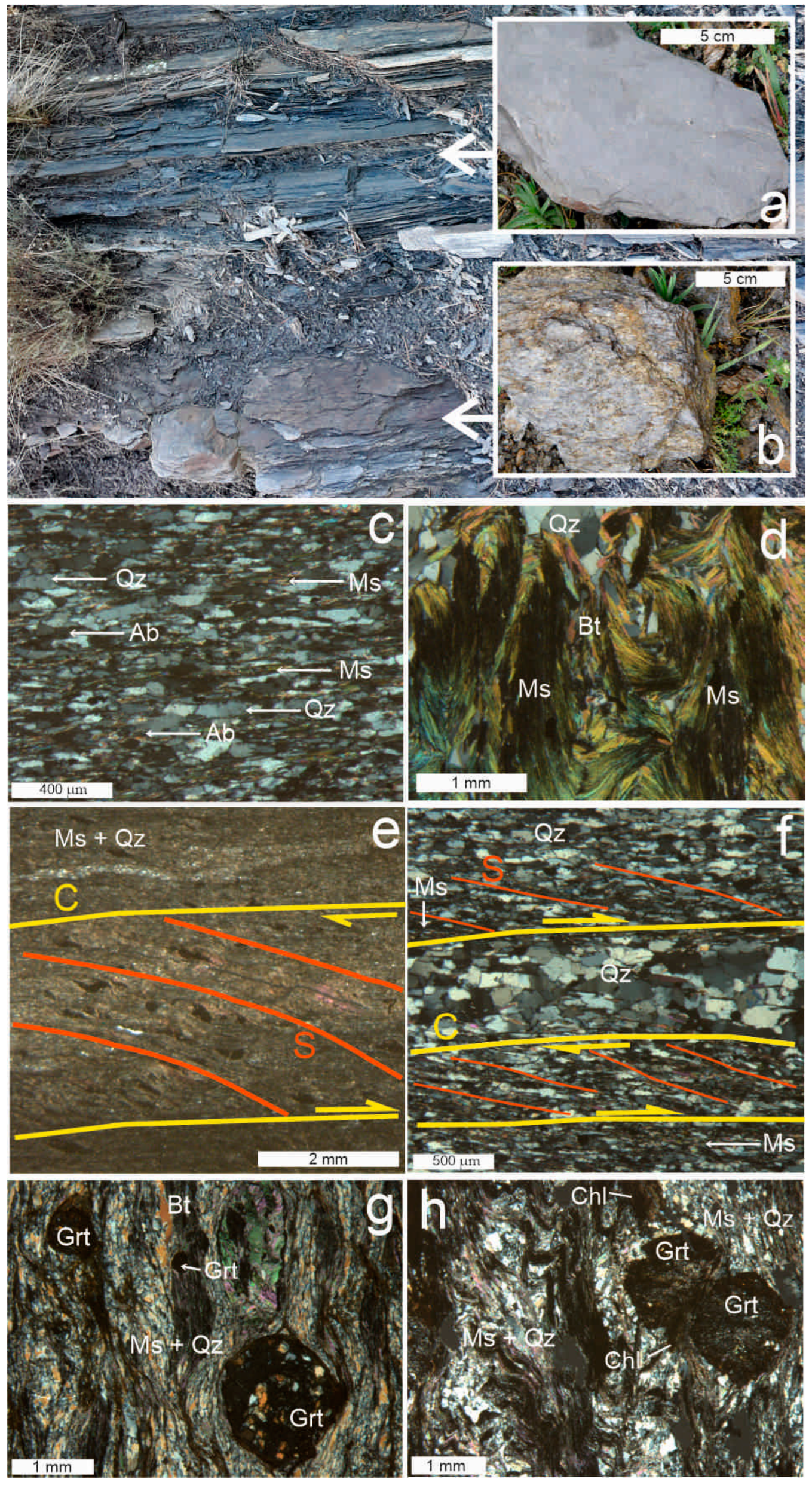
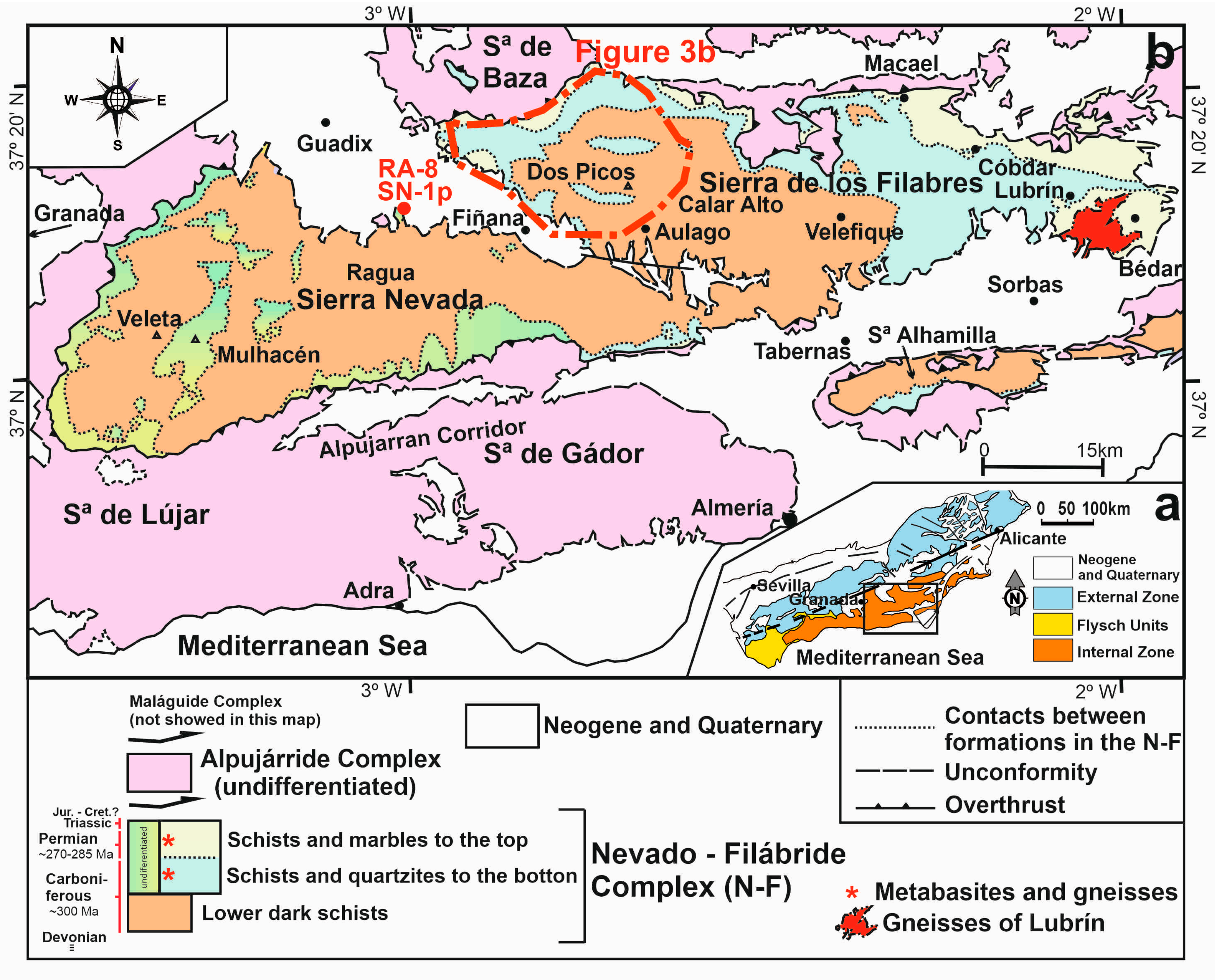

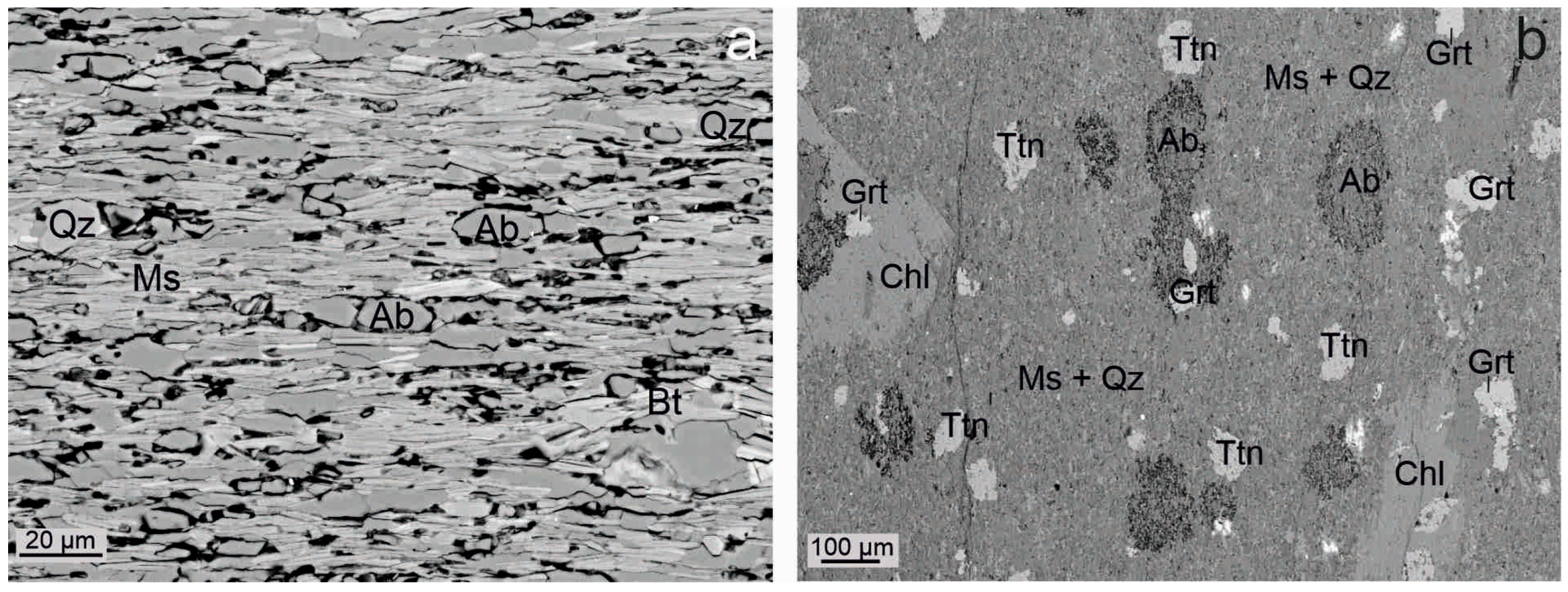


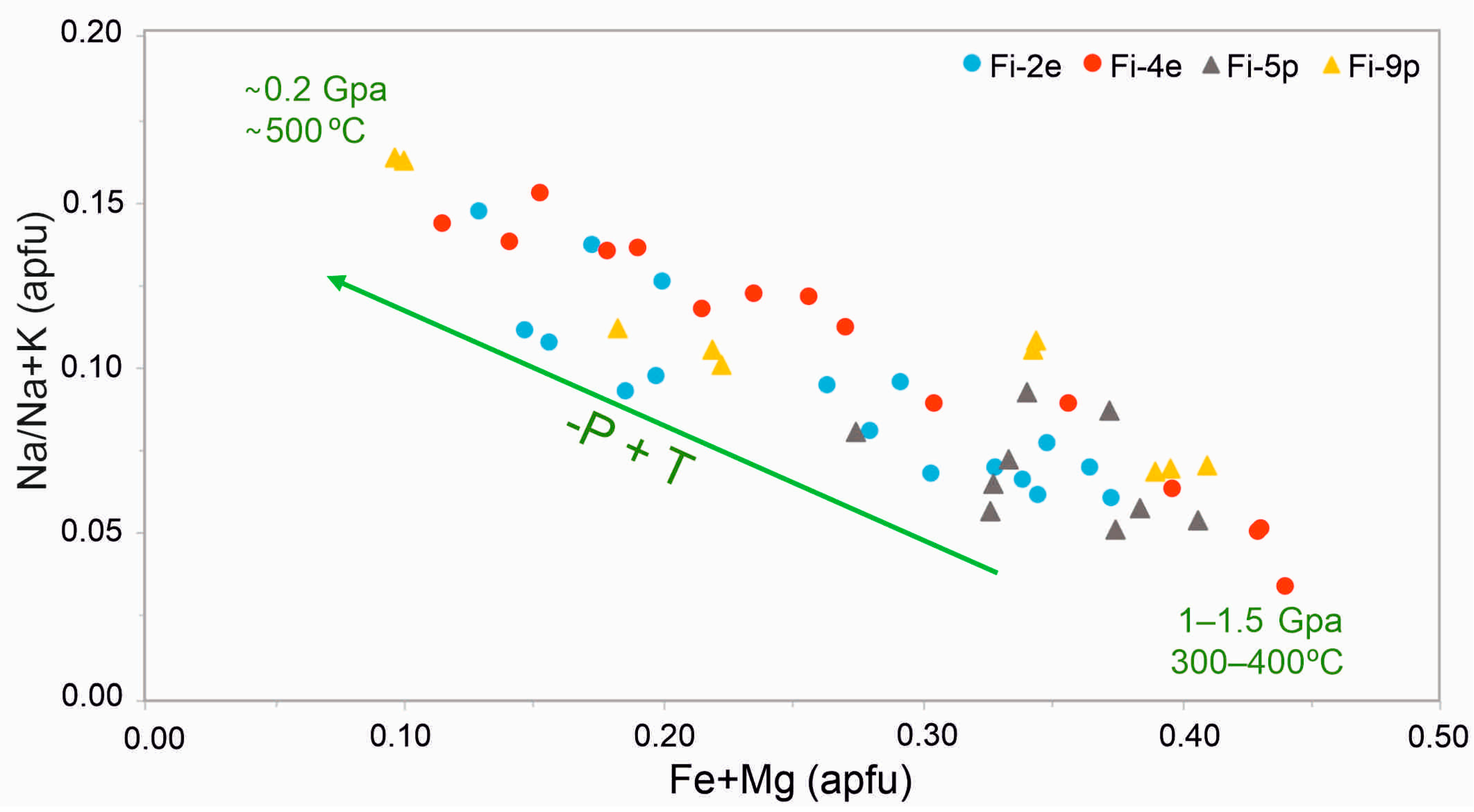
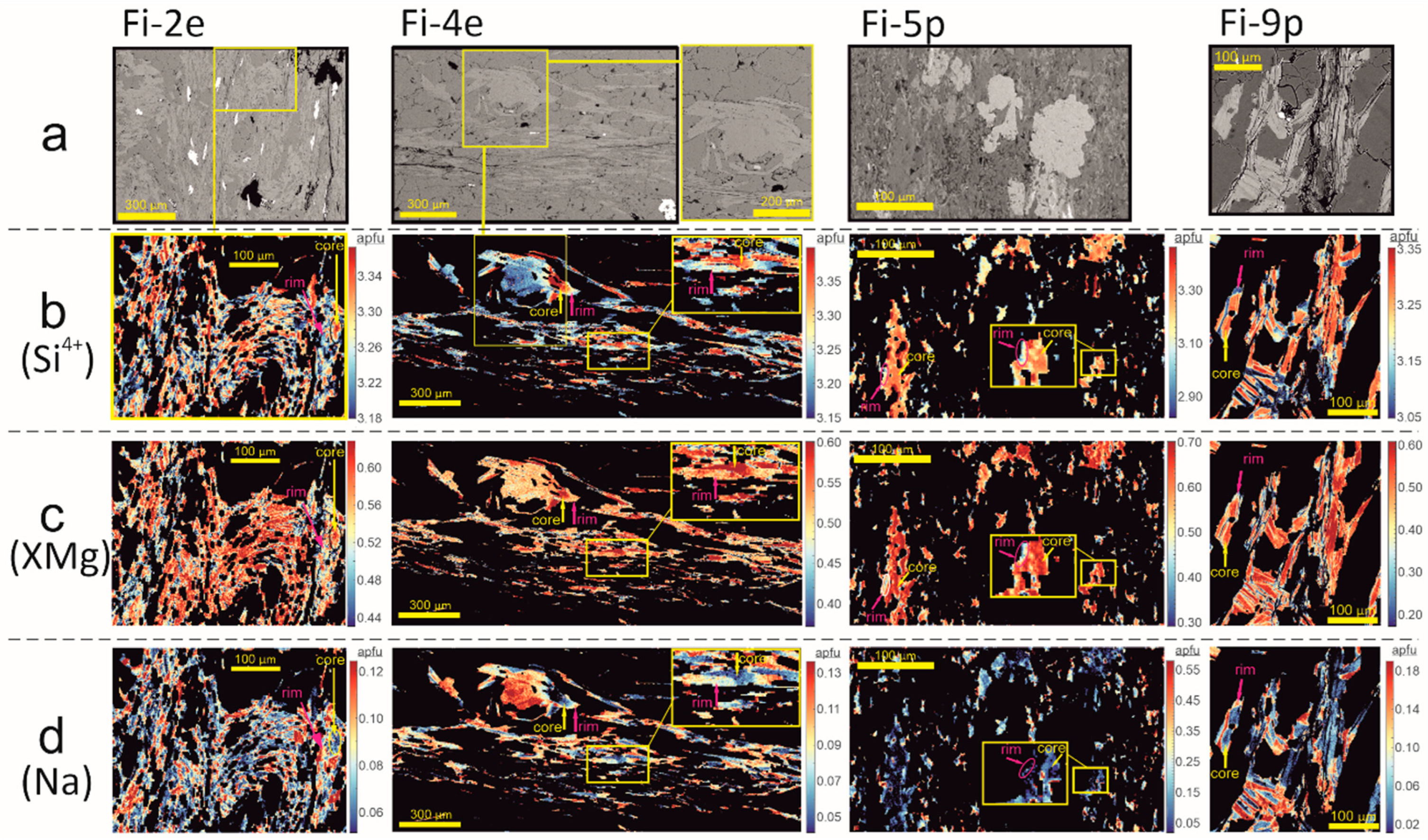

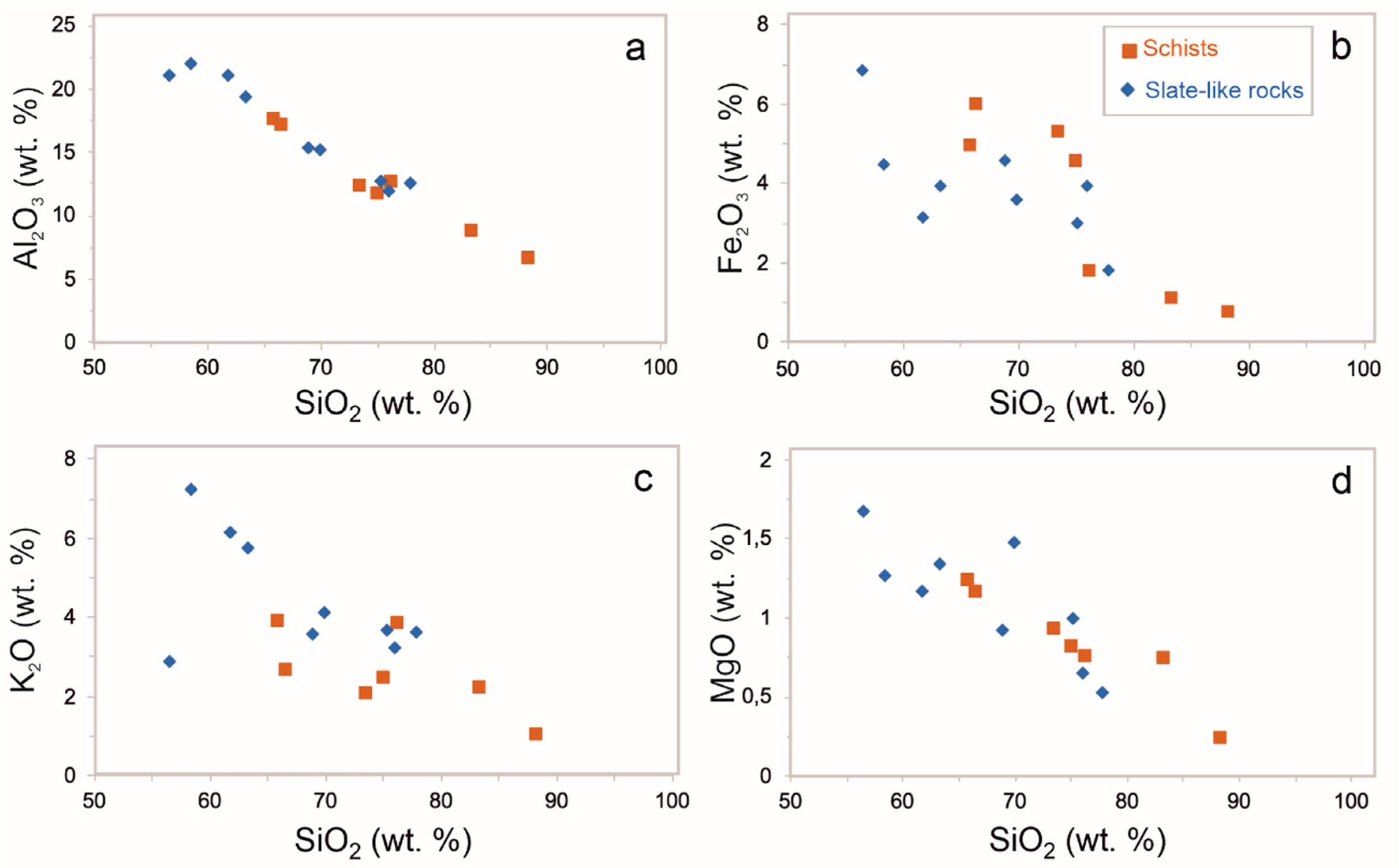
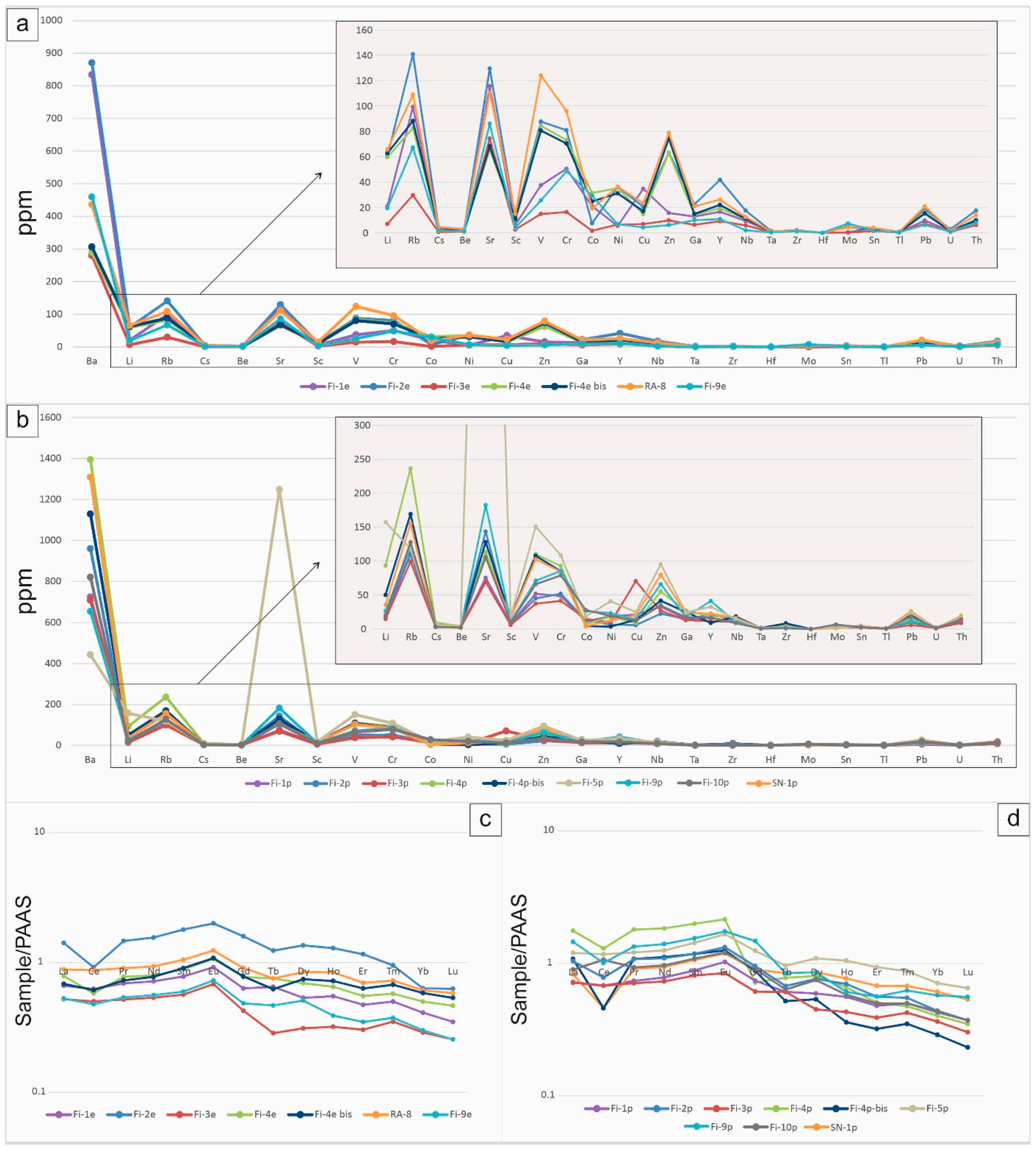

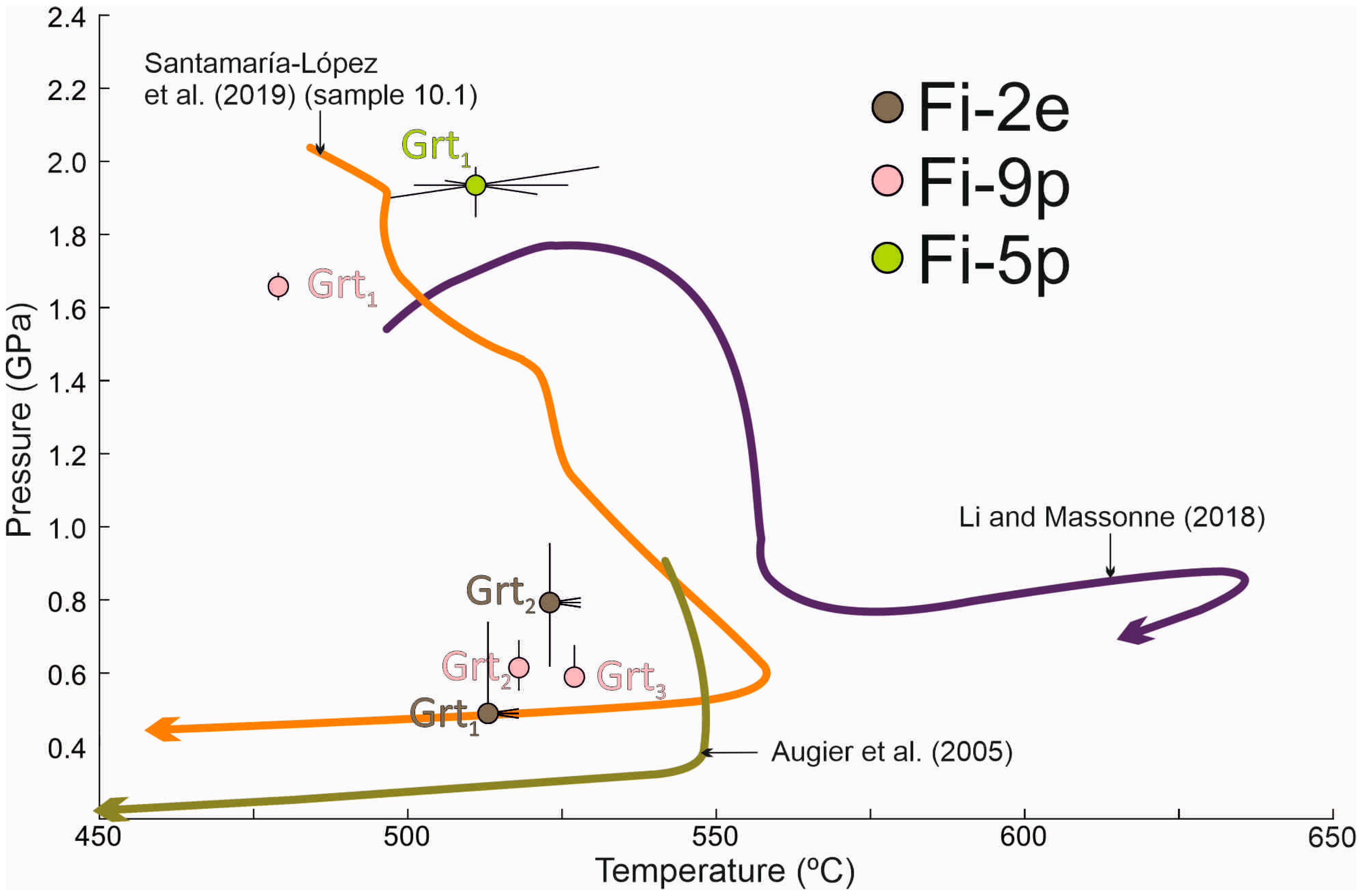
| Sample | Minerals (+Qz + Ph + Bt + Pl) | Illite “Crystallinity” (CIS) | |
|---|---|---|---|
| <2 µm | Whole Fraction | ||
| Fi-1p | Kfs, Sme, Kln | 0.25 | 0.23 |
| Fi-2p | Kfs, Kln | 0.24 | 0.20 |
| Fi-3p | Sme ↓↓, Kln | 0.21 | 0.20 |
| Fi-4p | Kln ↓↓ | 0.19 | 0.20 |
| Fi-4p-bis | Sme ↓↓, Kln ↓ | 0.24 | 0.21 |
| Fi-5p | Amp, Grt, Pg, Sme, Kln ↓ | 0.25 | 0.23 |
| SN-1p | Kfs, Sme, Kln | 0.23 | 0.26 |
| Mica Core | Mica Rim | |||||
|---|---|---|---|---|---|---|
| Si | XMg | Na | Si | XMg | Na | |
| schists | ||||||
| Fi 2e | 3.37 | 0.63 | 0.06 | 3.18 | 0.43 | 0.13 |
| Fi 4e | 3.40 | 0.63 | 0.03 | 3.14 | 0.40 | 0.15 |
| slate-like rocks | ||||||
| Fi 5p | 3.50 | 0.70 | 0.05 | 2.90 | 0.30 | 0.15 |
| Fi 9p | 3.35 | 0.65 | 0.02 | 3.05 | 0.2 | 0.20 |
| Samples | SiO2 | Al2O3 | Fe2O3 | MnO | MgO | CaO | Na2O | K2O | TiO2 | P2O5 | LOI | TOTAL (with LOI) |
|---|---|---|---|---|---|---|---|---|---|---|---|---|
| Fi-1e | 76.32 | 12.61 | 1.76 | 0.01 | 0.75 | 0.17 | 0.78 | 3.80 | 0.62 | 0.05 | 2.08 | 98.95 |
| Fi-1p | 75.21 | 12.79 | 2.98 | 0.01 | 1.00 | 0.20 | 0.90 | 3.65 | 0.58 | 0.07 | 2.45 | 99.80 |
| Fi-2e | 65.97 | 17.56 | 4.91 | 0.03 | 1.23 | 0.32 | 0.62 | 3.88 | 0.93 | 0.09 | 4.08 | 99.63 |
| Fi-2p | 77.82 | 12.59 | 1.81 | 0.01 | 0.53 | 0.17 | 0.73 | 3.60 | 0.80 | 0.08 | 1.91 | 100.04 |
| Fi-3e | 88.40 | 6.51 | 0.71 | 0.00 | 0.24 | 0.11 | 1.64 | 1.00 | 0.45 | 0.02 | 0.92 | 100.00 |
| Fi-3p | 75.98 | 12.01 | 3.91 | 0.01 | 0.66 | 0.09 | 1.20 | 3.23 | 0.66 | 0.09 | 2.22 | 100.06 |
| Fi-4e | 75.07 | 11.64 | 4.53 | 0.05 | 0.81 | 0.23 | 0.61 | 2.43 | 0.65 | 0.09 | 2.77 | 98.88 |
| Fi-4p | 58.36 | 22.00 | 4.46 | 0.02 | 1.27 | 0.16 | 0.19 | 7.23 | 1.01 | 0.10 | 5.14 | 99.93 |
| Fi-4e-bis | 73.55 | 12.31 | 5.23 | 0.04 | 0.92 | 0.26 | 0.60 | 2.06 | 0.70 | 0.11 | 3.15 | 98.92 |
| Fi-4p-bis | 61.75 | 21.10 | 3.15 | 0.01 | 1.17 | 0.11 | 0.94 | 6.13 | 1.03 | 0.06 | 4.50 | 99.95 |
| Fi-5p | 56.46 | 21.12 | 6.82 | 0.08 | 1.68 | 5.02 | 1.09 | 2.87 | 1.06 | 0.17 | 3.58 | 99.95 |
| Fi-9e | 83.43 | 8.78 | 1.06 | 0.00 | 0.74 | 0.15 | 0.32 | 2.16 | 0.49 | 0.02 | 1.79 | 98.94 |
| Fi-9p | 68.85 | 15.37 | 4.58 | 0.05 | 0.92 | 0.20 | 0.63 | 3.58 | 0.89 | 0.12 | 3.64 | 98.81 |
| Fi-10p | 69.91 | 15.26 | 3.59 | 0.02 | 1.48 | 0.12 | 0.51 | 4.11 | 0.68 | 0.04 | 3.06 | 98.78 |
| RA-8 (e) | 66.56 | 17.03 | 5.94 | 0.06 | 1.16 | 0.49 | 0.88 | 2.62 | 0.90 | 0.17 | 3.92 | 99.75 |
| SN-1p | 63.30 | 19.35 | 3.93 | 0.03 | 1.35 | 0.54 | 0.28 | 5.75 | 0.97 | 0.04 | 4.44 | 99.96 |
| SiO2 | 1.997 | Al2O3 | 2.209 | Fe2O3 | 0.522 | MnO | 0.039 | MgO | 1.572 |
| CaO | 0.791 | Na2O | 0.312 | K2O | 2.839 | TiO2 | 1.922 | P2O5 | 0.295 |
| Ba | 2.773 | Cr | 1.071 | Ta | 1.704 | Th | 2.051 | Tb | 0.351 |
| Li | 0.308 | Co | 0.993 | Zr | 2.139 | La | 1.761 | Dy | 0.247 |
| Rb | 2.603 | Ni | 0.810 | Hf | 1.370 | Ce | 1.462 | Ho | 0.338 |
| Cs | 1.693 | Cu | 0.498 | Mo | 0.827 | Pr | 1.719 | Er | 0.394 |
| Be | 2.038 | Zn | 0.436 | Sn | 1.568 | Nd | 1.657 | Tm | 0.439 |
| Sr | 1.025 | Ga | 1.996 | Tl | 2.397 | Sm | 1554 | Yb | 0.029 |
| Sc | 1.618 | Y | 0.084 | Pb | 0.805 | Eu | 1.312 | Lu | 0.312 |
| V | 0.909 | Nb | 1.732 | U | 0.889 | Gd | 0.834 |
Disclaimer/Publisher’s Note: The statements, opinions and data contained in all publications are solely those of the individual author(s) and contributor(s) and not of MDPI and/or the editor(s). MDPI and/or the editor(s) disclaim responsibility for any injury to people or property resulting from any ideas, methods, instructions or products referred to in the content. |
© 2022 by the authors. Licensee MDPI, Basel, Switzerland. This article is an open access article distributed under the terms and conditions of the Creative Commons Attribution (CC BY) license (https://creativecommons.org/licenses/by/4.0/).
Share and Cite
Santamaría-López, Á.; Abad, I.; Nieto, F.; Sanz de Galdeano, C. Early Mylonitization in the Nevado-Filábride Complex (Betic Cordillera) during the High-Pressure Episode: Petrological, Geochemical and Thermobarometric Data. Minerals 2023, 13, 24. https://doi.org/10.3390/min13010024
Santamaría-López Á, Abad I, Nieto F, Sanz de Galdeano C. Early Mylonitization in the Nevado-Filábride Complex (Betic Cordillera) during the High-Pressure Episode: Petrological, Geochemical and Thermobarometric Data. Minerals. 2023; 13(1):24. https://doi.org/10.3390/min13010024
Chicago/Turabian StyleSantamaría-López, Ángel, Isabel Abad, Fernando Nieto, and Carlos Sanz de Galdeano. 2023. "Early Mylonitization in the Nevado-Filábride Complex (Betic Cordillera) during the High-Pressure Episode: Petrological, Geochemical and Thermobarometric Data" Minerals 13, no. 1: 24. https://doi.org/10.3390/min13010024






